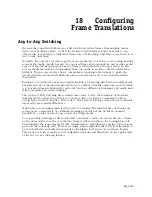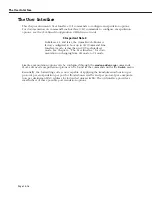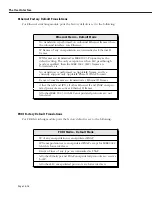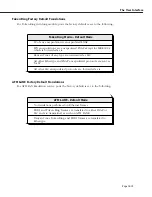
Configuring Encapsulation Options
Page 18-15
“Native” versus “Non-Native” on Ethernet
For the Ethernet one further distinction is made. If the frame received from the backplane is
an Ethernet media type frame from another Ethernet switching module in the same chassis,
then
no encapsulation translations are applied
. Such frames are referred to as Native frames.
If the frame is of an Ethernet media type but was put onto the backplane by some other type
of switching module, for example, the frame came from a FDDI card via a trunk port, or from
the MPX via routing, then
encapsulation translations are applied
. Such frames are referred to
as Non-Native frames.
♦
Important Note
♦
The
.cmd
file contains a command called
hreXnative
that by default is set to
1
. If your switch uses multiple
encapsulations (for example, VLAN 2:1 is 802.3 IPX and
VLAN 3:1 is Ethernet II IPX) then the
hreXnative
command must be set to
0
. See Chapter 7, “Managing
Files,” for more information on the
.cmd
file.
“Native” versus “Non-Native” on FDDI and Token Ring
For FDDI, Token Ring and LAN Emulation on ATM, a native/non-native distinction is not
made. Instead, no encapsulation translations are applied by these switching modules to
frames which are of their own media type.
No Translation on Trunk or PTOP ports
Switching modules which support encapsulation mechanisms, such as Trunking ports on
FDDI and Token Ring, and Point to Point ports on ATM do not apply translation to frames
destined to such ports.
All other aspects of the transformation process are driven by the media type of the frame, the
media type of the port on which the frame is to be transmitted and the protocol type deter-
mined for the frame. Thus frame padding insertion/stripping, IP fragmentation, IP ARP bit
swapping, etc., are all automatic.
The Proprietary Token Ring IPX Option
The one area which remains configurable is the bit swapping of source addresses for IPX in
order to allow Token Ring to work with FDDI and Ethernet. This is the equivalent function to
IP ARP bit swapping.
This option is configurable and by default is on.
Summary of Contents for Omni Switch/Router
Page 1: ...Part No 060166 10 Rev C March 2005 Omni Switch Router User Manual Release 4 5 www alcatel com ...
Page 4: ...page iv ...
Page 110: ...WAN Modules Page 3 40 ...
Page 156: ...UI Table Filtering Using Search and Filter Commands Page 4 46 ...
Page 164: ...Using ZMODEM Page 5 8 ...
Page 186: ...Displaying and Setting the Swap State Page 6 22 ...
Page 202: ...Creating a New File System Page 7 16 ...
Page 270: ...Displaying Secure Access Entries in the MPM Log Page 10 14 ...
Page 430: ...OmniChannel Page 15 16 ...
Page 496: ...Configuring Source Route to Transparent Bridging Page 17 48 ...
Page 542: ...Dissimilar LAN Switching Capabilities Page 18 46 ...
Page 646: ...Application Example DHCP Policies Page 20 30 ...
Page 660: ...GMAP Page 21 14 ...
Page 710: ...Viewing the Virtual Interface of Multicast VLANs Page 23 16 ...
Page 722: ...Application Example 5 Page 24 12 ...
Page 788: ...Viewing UDP Relay Statistics Page 26 24 ...
Page 872: ...The WAN Port Software Menu Page 28 46 ...
Page 960: ...Deleting a PPP Entity Page 30 22 ...
Page 978: ...Displaying Link Status Page 31 18 ...
Page 988: ...Displaying ISDN Configuration Entry Status Page 32 10 ...
Page 1024: ...Backup Services Commands Page 34 14 ...
Page 1062: ...Diagnostic Test Cable Schematics Page 36 24 ...
Page 1072: ...Configuring a Switch with an MPX Page A 10 ...
Page 1086: ...Page B 14 ...
Page 1100: ...Page I 14 Index ...
















































